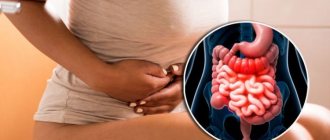Flatulence
– this is an excessive accumulation of gases in the gastrointestinal tract, which can be caused either by increased gas formation or problems with the removal of gases from the body. Gases, as a rule, accumulate either in the stomach or in the right or left bends of the colon.
Gases enter the digestive tract either through the mouth (thus, air is swallowed in small quantities when eating - with each swallow), or are produced during the digestion process. A significant volume of gases is also released when gastric juice is neutralized with soda (some patients with heartburn take soda just to neutralize the acid of the gastric juice, which irritates the gastric mucosa). In small quantities, gases enter the intestines through the bloodstream. Gases are eliminated mainly through the rectum. The volume of gases released in a healthy person varies quite widely. Flatulence is diagnosed when a person experiences discomfort due to an increased amount of gas in the stomach or intestines.
What is bloating
Bloating or flatulence is a syndrome caused by the accumulation of excess gases in the gastrointestinal tract.
Bloating can occur both with excessive formation of gases in the digestive organs and with their insufficient removal. Gas retention is more common in the afternoon, when the digestive system is at its most active. Discomfort may go away after visiting the toilet, but sometimes even the act of defecation does not help - gas continues to accumulate and periodically exits through the anus with various unpleasant odors and loud sounds.
Flatulence is not a separate disease; this condition is manifested by a variety of symptoms, and its occurrence can be influenced by many factors.
Periodic bloating is familiar to absolutely everyone; it is usually associated with eating food that causes increased gas formation, and goes away quite quickly. But constant discomfort and pain in the abdomen indicate the presence of pathology. Very often, bloating is associated with a significant accumulation of feces in the large intestine, excess fat in the abdominal area, and fluid retention in the body. The effectiveness of further treatment depends on the correct identification of the causes of bloating.
Diagnostic methods
A certain amount of accumulated liquid mass (more than half a liter) can be determined during a medical examination. To confirm a preliminary diagnosis, an ultrasound is necessary.
The main problem is not to detect the liquid, but to identify the cause of its accumulation. Only then will the treatment be effective. To do this, it is necessary to conduct laboratory tests, namely:
- Blood clotting test;
- Biochemistry analysis;
- Analysis of ascitic fluid obtained during laparocentesis
Causes of bloating
The human intestine produces gas every day, but most of it, about 70%, we absorb through air during meals. Every time we swallow food, 2-3 ml of air enters the stomach with it.
Normally, about 200 ml of gas is constantly present in the intestines of a healthy adult, and the total circulation per day is 20 or more liters. During the same time, from 200 ml to 2 liters of gas are released through the rectum.
The stomach already contains a certain amount of carbon dioxide, a product released during the reaction of hydrochloric acid with foods containing alkalis. Carbon dioxide is also formed in the duodenum when the components of pancreatic juice react with hydrochloric acid coming from the stomach.
Gases in the intestines are formed from several sources:
- gas released during fermentation and rotting of food;
- products of metabolic activity of bacteria formed during the fermentation process;
- gas coming from the circulatory system.
The air supplied with food combines with the gases in the digestive organs, forming foam from small bubbles. These bubbles are covered with slippery mucus, which allows gas to move freely towards the anus during peristalsis.
Organic substances that are not absorbed in the small intestine enter the large intestine. Their composition determines the smell of gas. The unpleasant odor of gases and feces is associated with the formation of hydrogen sulfide and ammonia during the breakdown of proteins. If the products of protein metabolism predominate over other components, the smell of rotting food appears. Plant fibers, cellulose and complex carbohydrates form a large volume of gas, which is dominated by odorless carbon dioxide.
The composition of the gas and its quantity in various segments of the digestive system are determined by the balance between the processes of formation and elimination. Bloating occurs when more gas accumulates in the intestines than the body can eliminate.
Causes of bloating of a physiological nature
All causes of bloating are divided into two large groups: periodic functional disorders that occur in healthy people under the influence of certain factors, and manifestations of various diseases of the digestive system. Common causes of bloating not associated with systemic diseases include:
- Improper eating behavior. Lack of diet, too much food eaten at one time, overeating at night, sedentary lifestyle, constant snacking on unhealthy foods.
- Switching to unusual food products, for example, when traveling to a country with specific culinary traditions. Bloating can also occur when switching to an unbalanced diet in order to lose weight. The cause of the painful condition is a lack of pancreatic enzymes necessary for digesting unfamiliar foods.
- Frequent consumption of foods that stimulate excessive gas formation, for example, kvass and black bread, which begin the fermentation process when they enter the intestines.
- Air travel. The so-called high-altitude flatulence is associated with the expansion of gases and an increase in their pressure on the digestive organs due to a decrease in atmospheric pressure at high altitudes.
- Hormonal changes during the menstrual cycle and pregnancy.
All these reasons do not imply pathologies of internal organs. They are periodic in nature and disappear after the elimination of the factors that caused the discomfort.
Flatulence is common in old age due to inevitable changes in intestinal physiology. Over time, atrophy of the intestinal muscle wall occurs and a decrease in the functionality of digestive juices. As a result, gases and undigested foods are retained in the intestinal lumen, causing flatulence.
Swallowing air
Flatulence caused by swallowing excess air while eating is called aerophagia.
Air swallowed while eating and drinking makes up more than half of the composition of intestinal gas. Swallowing air is associated with:
- quick food on the go,
- talking while eating,
- insufficient chewing and swallowing large pieces,
- smoking while eating,
- drinking carbonated drinks,
- drinking drinks through a straw.
A large volume of air enters the stomach when chewing gum constantly.
After eating in a hurry, part of the swallowed air comes out with belching, but the other part enters the gastrointestinal tract.
Another cause of aerophagia is poorly fitting dentures. A lot of air enters the stomach and with increased salivation, which occurs during neuroses and stress or as a result of certain diseases of the digestive system, for example, pancreatitis or stomach ulcers.
Diseases that cause bloating and gas
Almost all acute or chronic diseases of the digestive system can cause bloating, as they disrupt the processes of digestion and absorption of food and impair intestinal motility.
Most often, flatulence is one of the symptoms:
- inflammation due to colitis, gastritis, enteritis;
- irritable bowel syndrome;
- inflammation of the pancreas - pancreatitis;
- inflammation of the gallbladder and biliary tract - cholecystitis;
- tumors of the stomach and intestines of any etiology, adhesions, the presence of intestinal parasites (worms), etc.;
- acute appendicitis;
- poisoning causing intestinal motility disorders;
- lactose intolerance;
- gluten intolerance - a group of proteins found in cereals;
- neuroses and other diseases of the central nervous system.
An enlarged abdomen is not always associated with excess gas in the intestines. A big belly also appears with obesity. A person may feel quite satisfactory, but we must not forget that excess fat in the abdominal area disrupts the rate of metabolic processes and is a risk factor for the development of hypertension, diabetes and other serious pathologies.
Bloating almost always accompanies another functional disorder of the digestive system - irritable bowel syndrome. With this pathology, gastrointestinal diseases are not detected, and intestinal motility is impaired due to problems of a nervous or humoral nature.
The main symptom of irritable bowel disease is frequent abdominal pain and bowel movements. The stool can be either liquid or too hard, causing constipation. Flatulence accompanies both forms of the disorder. Gases in irritable bowel syndrome are formed due to changes in intestinal microflora and slower motility due to problems with reflex regulation.
A lack of digestive enzymes can occur due to inflammation of the pancreas. As a result, it is not the fermented lump that enters the large intestine, but unprocessed food. Under the influence of bacteria in the colon, food begins to decompose and ferment, producing a significant amount of gas.
A disease not related to the gastrointestinal tract, but causing bloating - ascites. This pathology is characterized by the accumulation of a large amount of fluid in the abdominal cavity. Ascites can be a symptom of severe infection, cirrhosis of the liver, heart and vascular problems, and portal vein thrombosis. This condition requires immediate medical attention.
Flatulence can also be an indirect sign of uterine fibroids, fibroids and ectopic pregnancy. Increasing in size, the uterus begins to squeeze the rectum, preventing the normal release of gases.
Lactose intolerance
Lactase deficiency is another common cause of bloating.
The essence of the pathology is the absence or insufficient activity of the lactase enzyme, whose task is to break down lactose (milk sugar) into glucose and galactose. Milk sugar, unlike glucose and galactose, does not have the ability to be absorbed into the blood and enters unchanged into the large intestine. There, bacteria break it down, and its disposal takes place with the release of a large volume of gas. The test for determining lactase deficiency using exhaled air analysis is based on the features of this process. Pathology is indicated by a high concentration of hydrogen in it. Another symptom of the disease is loose stools with foam and a characteristic sour odor due to increased secretion of water under the influence of undigested lactose.
Lactase deficiency occurs only when drinking whole milk. There is much less milk sugar in kefir, yogurt and other fermented milk products, and there is none at all in cheese and cottage cheese.
Representatives of some peoples at the genetic level cannot tolerate milk sugar, for example, the adult population of Africa. The gene for lactose tolerance is not formed among peoples who have been engaged in crop production rather than agriculture for a long time - the Japanese, Chinese and some other representatives of Asian countries.
Lactase deficiency is sometimes diagnosed in weak premature babies, but these cases are quite rare. Before transferring a newborn to lactose-free formulas, it is necessary to undergo a thorough examination. The situation becomes much more dangerous if the baby is intolerant to casein - the main milk protein, which is found in absolutely all dairy products, including cheese, cottage cheese and all fermented milk products. In this case, the child can be fed only with plant-based milk (Fig. 1), for example, soy milk, and introduced vegetable complementary foods and gluten-free cereals.
Figure 1. Almond and other plant milks do not contain lactose or the milk protein casein. Source: unsplash.com
Every third pregnant woman experiences bloating in the second or third trimester. Increased gas formation is accompanied by frequent belching, heartburn and problems with bowel movements. This may be due to the following factors:
- enlargement of the uterus and its pressure on the intestines;
- slower peristalsis due to hormonal changes;
- increased load on the liver and pancreas and insufficient production of digestive enzymes.
What foods cause bloating in adults?
Flatulence is caused by a large number of foods; this list is largely individual. Some people do not tolerate exotic fruits and unfamiliar cuisine well, while others experience bloating from foods traditional to our latitudes or combinations thereof. But most provoking foods are well known (Fig. 2); they are present in each group:
- Bread and pastries. Gas formation begins after eating products made from yeast dough, since yeast is a fungus that causes the fermentation process. Fresh white bread and baked goods are especially active in causing flatulence. Black bread also begins to actively ferment under the influence of gastric juice, which is why it is used in the production of kvass.
- Milk causes bloating, but fermented milk products, on the contrary, normalize the balance of intestinal microflora.
- Vegetables are the largest group of foods that cause bloating. Fermentation in the intestines is caused by all types of cabbage, especially white cabbage; legumes, especially beans and peas, remain undigested in the intestines for a long time and cause rapid proliferation of bacteria; fresh herbs, cucumbers, all types of radishes, tomatoes, potatoes.
- Fruits. Gas formation when eating fruits is associated with their high sugar content, which stimulates the fermentation process. A particularly active process is caused by grapes, pears, peaches and other juicy sweet fruits.
Other products worth noting are eggs, pork and lamb, and mushrooms. Bloating is caused by large amounts of slowly digested protein and coarse plant fibers. Active fermentation is also provoked by fast carbohydrates.
To prevent your favorite foods from causing flatulence, you can change the cooking method. For example, stewed cabbage does not stimulate gas formation. Cucumbers can be poured with vegetable oil, and legumes can be pre-soaked in water for several hours.
Neutral foods can also cause flatulence if consumed regularly. For example, rice and fish do not activate fermentation, but if you eat only sushi and rolls, constipation will begin very quickly, and with them the process of rotting with increased release of gases.
Figure 2. Foods that cause bloating. Source: MedPortal
Who is most likely to experience bloating?
Despite the fact that bloating in itself is not a disease and can periodically appear in completely healthy people, there are risk groups in which this condition appears very often:
- Overweight people - excess body weight increases the load on all body systems, including the digestive organs. In addition, excess weight usually appears in people with poor eating habits, who prefer fatty and sweet foods in excessive quantities.
- Smokers. Swallowing air occurs not only when smoking regular cigarettes, but also when using electronic gadgets and hookahs.
- Pregnant women due to an increase in the size of the uterus.
- People with chronic diseases of the digestive system, even during remission.
- People suffering from chronic bronchitis and pulmonary diseases. Problems with the bronchi and lungs can also provoke flatulence, since difficulty breathing is one of the reasons for swallowing air while eating.
20-30% of people suffer from bloating from time to time. This is a very common syndrome.
Effective drugs against flatulence
Treatment of disorders of the stomach and intestines is carried out using various groups of medications, as well as mandatory nutritional correction. To restore digestion, carminatives and enzyme agents, enterosorbents, prokinetics, prebiotics and probiotics can be used. If gas formation is accompanied by pain, antispasmodics are additionally prescribed.
| Medicine | Active substance | Manufacturer | average cost |
| Espumisan | Simethicone | Berlin-Chemie AG/Menarini Pharma HmbX (Germany) | 270-470 rubles |
| Pepphys | Amylase, papain, simethicone | Ranbaxy (India) | 420-480 rubles |
| Antareit | Simethicone, magaldrate | JSC Valenta Pharm, Russia | 190-320 rubles |
| Meteospasmil | Simethicone | Laboratoires Mayoly-Spindler (France) | 440-470 rubles |
| Imodium | Loperamide | Johnson & Johnson (Russia) | 160-250 rubles |
| Pepsan-R | Dimethicone | Laboratoires Rosa-Phytopharma (France) | 400-430 rubles |
| Holenzym | Dried bile, dried pancreas | RUE "Belmedpreparaty", Republic of Belarus | 185-245 rubles |
| Motilium | Domperidone | Johnson & Johnson (Russia) | 570-700 rubles |
| Linex | Lebenin | Sandoz d.d., Verovshkova 57, 1000 Ljubljana, Slovenia | 320-620 rubles |
| Smecta | Dioctahedral smectite | Bofur Ipsen Industry. 28100 France, Dreux, Rue et Virton | 125-150 rubles |
| Festal | Pancreatin | Aventis Pharma International (France) | 220-300 rubles |
| Cerucal | Metoclopramide | Teva (Israel) | 120-220 rubles |
In order to quickly get rid of flatulence, constipation and digestive disorders, it is best to take medications from several groups. But any medications should only be prescribed by a doctor, taking into account existing contraindications and age restrictions.
Where does bloating occur?
Bloating occurs in different parts of the digestive tract.
In the stomach
The stomach always contains a certain amount of air that enters it during meals. The natural mechanism for getting rid of excess air is belching; the remaining volume enters the small intestine.
The stomach contains mainly nitrogen and oxygen - gases contained in the atmosphere and have no odor. An unpleasant odor occurs when gases pass through the small and large intestines.
In the small intestine
In the small intestine, gas bubbles combine with liquid digested food and are absorbed through its mucous membrane.
In the duodenum (the initial part of the small intestine), the reaction of hydrochloric acid with alkali produces carbon dioxide. Under normal conditions, most of the carbon dioxide is absorbed into the blood, and the rest passes further into the large intestine. When carbon dioxide is produced in excess, it is retained in the small intestine, causing bloating.
In the large intestine
Feces accumulate in the large intestine, and gases are not absorbed into the blood. They can only come out through the rectum. Depending on the volume of gas accumulated in the colon, it is released at different frequencies.
Gases affect the functioning of the large intestine in different ways. Thus, an excessive amount of methane in the gas composition leads to constipation, because methane impedes the movement of feces through the rectum. An increased concentration of hydrogen negatively affects motility, but activates movement in the lower parts of the colon.
When there are problems with digestion and undigested food enters the large intestine, the compounds indole and skatole are formed. When they combine with hydrogen sulfide, they acquire a sharp, unpleasant odor.
Pankreoflat
The active ingredients of this anti-bloating remedy are dimethicone and pancreatin, that is, it is a drug of the enzymatic group. "Pankreoflat" destroys foam in the intestines and works as an enzyme, improving the secretion of the pancreas. An ideal drug for the treatment of bloating due to chronic pancreatitis. After all, with pancreatitis, food is poorly digested and begins to rot in the intestinal lumen. "Pankreoflat" contains enzymes such as lipase, amylase, trypsin - they break down food and help it be absorbed. Pankreoflat is usually prescribed for diseases of the pancreas, liver, biliary tract, gas formation after operations on the gastrointestinal tract, and digestive insufficiency. Take the drug with food - this is how it works best. "Pankreoflat" is well tolerated. But it should be remembered that it cannot be used during treatment with Gastal or Phosphalugel (otherwise the therapeutic effect of Pankreoflat will decrease). The product is contraindicated for pregnant women and breastfeeding.
Pankreoflat
Solvay, Belgium
Pankreoflat is a product containing active enzymes aimed at compensating for exocrine pancreatic insufficiency.
Tablets are used to eliminate the consequences of impaired functioning of the pancreas, in the treatment of digestive disorders, or for the purpose of rehabilitation of a patient after operations on the digestive tract. from 2200
5.0 1 review
377
- Like
- Write a review
Symptoms of bloating
Excess gas in the digestive system is manifested by general discomfort and some unpleasant symptoms:
- pain and heaviness in different parts of the abdomen or throughout its entire area;
- loud sounds in the stomach, a feeling of constant movement in it;
- release of gas with an unpleasant odor, accompanied by loud sounds.
Sometimes there are complaints of frequent belching with an unpleasant aftertaste, heartburn, indigestion, sleep problems, and emotional instability.
Subjective sensations depend on the specific area of the digestive tract in which gases accumulate. If the delay occurs in the area of the splenic flexure, then the complaints are associated with pain in the left hypochondrium, radiating to the heart, and general bloating. Accumulation in the area under the liver is manifested by pain in the right hypochondrium and a feeling of fullness in the stomach.
Flatulence of the small intestine is characterized by general bloating of the abdomen, and of the large intestine - on the sides.
What examinations need to be performed?
Due to the numerous causes of flatulence, it is difficult to immediately determine a diagnostic method to identify the source of the problem. The patient’s initial visit takes place at an appointment with a local therapist, who will give a referral for further examination by a gastroenterologist. Most of the patients who complained of gas accumulation had gastrointestinal disorders.
The list of necessary examinations includes:
- After a visual examination and palpation of the swellings, the patient is referred for colonoscopy and endoscopy. Having received the main indicators, a biopsy is taken from the stomach to study the problem in more detail.
- An ultrasound of the abdominal cavity allows you to see a full picture of what is happening, possible deviations, the condition of the organs, the presence of a cyst. If necessary, the doctor conducts an additional ultrasound examination of the liver, stomach, and pancreas.
- Examination of the abdominal cavity using an X-ray machine. The walls of the large and small intestines are visible.
- Passing pH measurements to identify disorders of gastric secretions.
- Blood and stool tests, which are given and examined in the laboratory.
What to do if you have bloating
You can alleviate the condition of bloating by taking certain medications, but taking them without consulting a doctor, relying only on advertising, is very dangerous. If you have abdominal pain, you can take antispasmodics, but it is best to give up junk food for a while and lie down quietly.
When should you go to the doctor?
Check with your doctor if bloating is accompanied by any of the following symptoms:
- severe or prolonged abdominal pain;
- blood in the stool or dark, tarry stool;
- heat;
- diarrhea;
- worsening heartburn;
- vomit;
- asymmetrical abdominal enlargement;
- unexplained weight loss.
If the condition is not acute and does not allow you to leave the house, you should call an ambulance. Bloating may be a sign of acute appendicitis or intestinal obstruction, these conditions require urgent medical attention.
Signs that bloating is caused by a serious problem
Sometimes, based on symptoms, you can suspect a possible cause of bloating:
- Pain and bloating after eating foods made from rye, wheat or barley may indicate celiac disease, a disease associated with gluten intolerance.
- Bloating followed by constipation or diarrhea may mean a person is suffering from irritable bowel syndrome.
- Pain in the right lower abdomen may indicate appendicitis.
- Bloating after eating certain foods can be a sign of a food allergy.
- Painful bloating along with a feeling of nausea may be associated with cholelithiasis.
- In women, bloating and menstrual irregularities may be symptoms of ovarian cancer.
- Pain and bloating when the stomach is empty may indicate ulcers.
Symptomatic therapy
Flatulence of nutritional origin noticeably decreases or completely disappears after correcting the diet with a restriction in the diet of legumes, cabbage, black bread, and other products that increase gas formation in a particular person. It is recommended to eat regularly in a calm environment, chew food thoroughly, avoid eating dry food, and do as much physical exercise as possible. Until the reasons that provoked tympany are clarified, in case of severe bloating, the use of carminatives is effective. adsorbents, surface-active defoamers.
Frequent swelling, especially when combined with colicky pain, dyspepsia and stool disorders, is an indication for consultation with a gastroenterologist or proctologist. In case of severe flatulence with increasing pain, retention of gases and stools, or indomitable diarrhea, urgent medical attention is necessary.
Why is there constant bloating?
If abdominal discomfort persists for a long time, then this is a serious reason to contact a therapist and gastroenterologist. Constant bloating is an alarming symptom, indicating the presence of pathology of the digestive system. Particular concern should be caused by the fact of malaise against the background of normalization of nutrition and the abandonment of bad eating habits.
In diseases of the digestive system, bloating is accompanied by a set of other symptoms: severe pain, weakness, nausea, heartburn, diarrhea or constipation.
Treatment for bloating
There is no single treatment regimen for bloating, as it depends on why the condition occurs.
If bloating bothers you very often, you need to consult a gastroenterologist and undergo a comprehensive examination. Treatment is determined by the presence of the underlying disease.
Medicines for bloating and intestines
Any medications are taken only in consultation with a gastroenterologist.
The treatment package includes:
- defoamers - to destroy gas bubbles and facilitate the release of gas to the outside;
- activated carbon and other enterosorbents for collecting toxic bacterial waste;
- prokinetics - to stimulate peristalsis;
- preparations with enzymes to improve digestion;
- probiotics - live bacteria to normalize microflora;
- antispasmodics - to relieve pain.
For constipation, take laxatives, but we should not forget that frequent use of such drugs negatively affects intestinal motor function.
Diet
We cannot talk about any special diet for bloating, since this condition is not a disease. But if attacks occur regularly, then you should adhere to some recommendations for nutrition:
- You need to eat several times a day in small portions, avoid overeating;
- last meal - no less than 4 hours before bedtime;
- limit hard-to-digest foods in your diet - legumes, cabbage, sweet fruits;
- do not drink carbonated drinks, including beer;
- gradually introduce foods rich in fiber into the diet;
- consume fermented milk products, they contain bacteria that are beneficial for the stomach - probiotics;
- exclude fried foods;
- increase the amount of protein in your diet.
Switching to proper balanced nutrition normalizes the functioning of the digestive system and helps to avoid attacks of flatulence.
Treatment of bloating with folk remedies
Traditional medicine offers many recipes to relieve bloating, but they must be used with caution. Any plant is a potential allergen, and failure to comply with the proportions can lead to dire consequences. Before using alternative medicine, you should consult your doctor.
Among the folk remedies with a carminative effect are:
- fennel infusion - 2.5 g of seeds per glass of water;
- mint - boil 10 g of mint leaves in a glass of water for several minutes, let it brew and strain, drink no more than three cups a day;
- anise - boil 2 star anise in a glass of water, cool and drink twice a day.
Chamomile infusion helps with bloating (Fig. 3). In emergency cases, if you have severe heartburn, you can drink a glass of water with a teaspoon of soda.
Figure 3. Plants that help relieve bloating. Source: MedPortal
Plantex
An excellent anti-bloating drug for those who value natural ingredients. Plantex is prescribed for intestinal colic and for its prevention. The active ingredient of Plantex is fennel fruit extract. Fennel is beneficial for the gastrointestinal tract because it contains essential oils, organic acids and vitamins. The product relieves pain during flatulence and helps gases escape. You can buy Plantex in bags containing light brown granules. They are dissolved in 100 ml of warm boiled water and stirred until completely dissolved. The active substances of the drug are completely absorbed and quickly relieve bloating. The disadvantage of this product is that it contains sugar.
Plantex
Lek d.d., Slovenia
As a preventive and therapeutic agent in children from 2 weeks of age and older: - to eliminate spastic pain in the intestines with mild digestive disorders;
- when switching from breastfeeding to other types of nutrition. from 285
5.0 1 review
894
- Like
- Write a review
Prevention
Normalizing your diet and healthy lifestyle will help you avoid attacks of flatulence (Fig. 4).
Basic principles of prevention:
- eat often, but in small portions;
- pay attention to physical activity;
- monitor your weight;
- give up carbonated drinks;
- do not chew gum or eat on the go;
- drink more plain clean water;
- include fermented milk products with prebiotics in your diet;
- Keep a food diary to find out which foods cause bloating.
Figure 4. Prevention of flatulence.
Diet
Eliminating certain vegetables and carbohydrate foods such as beans, broccoli, cabbage, and certain artificial sweeteners such as sorbitol (found in chewing gum, candy, and some soft drinks) may reduce the amount of gas produced.
Avoid or limit consumption:
- carbonated drinks;
- fried and fatty foods;
- sugar;
- alcohol;
- lactose and gluten (if intolerant or allergic).
Sources
- Management of common gastrointestinal symptoms in the general population. A global view of heartburn, constipation, flatulence and abdominal pain/discomfort // Global practical recommendations of the World Gastroenterological Organization. - May, 2013.
- Hyun Jik Lee, Kyung Sik Park. Bloating [Electronic resource] // Korean Journal of Gastroenterology, December 2021.
- Max Schmulson. Understanding Bloating and Distension [Electronic resource] // International Foundation for Functional Gastrointestinal Disorders, 2013.
- Nayoung Kim, Dong Hyun Oh. Abdominal Bloating: Pathophysiology and Treatment [Electronic resource] // Journal of Neurogastroenterology and Motility, October 2013.
- Carly Gennaro, Helaine Larsen. Symptomatic Approach to Gas, Belching and Bloating with OMT Treatment Options [Electronic resource] // Osteopathic Family Physician, 2021.









